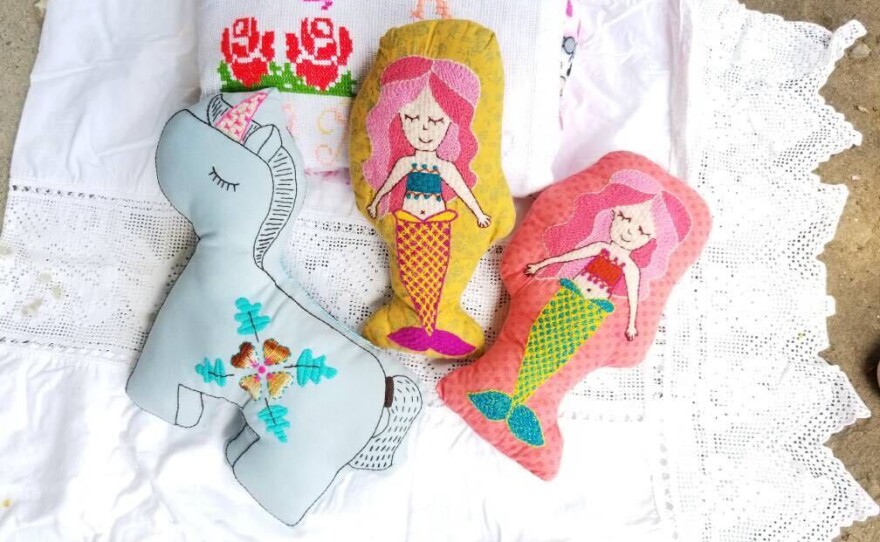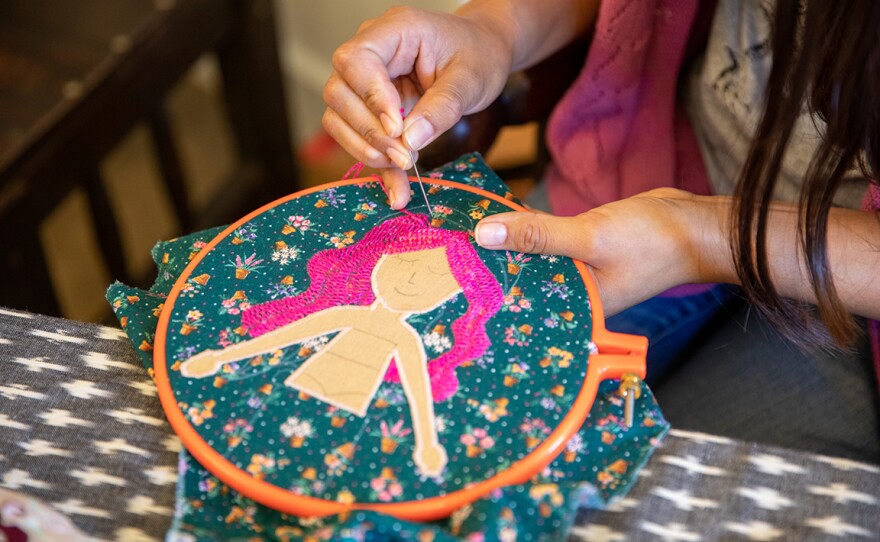"My mom and her five sisters and my grandma would get together every afternoon to watch their Mexican soap operas and gossip about the community. And there would always be a needle and thread," said arts educator Mayra Camacho of her earliest memories of her family ranch in the Mexican state of Querétaro — and her earliest memories of the ubiquitous stitching.
Raised in a fiber art and craftsmanship-oriented family, Camacho learned to embroider and crochet early, at age 8, though at the time, she felt like she had been wanting to learn and asking to join in since she was a baby.
Now Camacho is passing on her talents to a new crop of learners, regardless of their age, with a virtual Mingei International Museum kit-based instructional workshop as part of their Mingei Makers series. The workshop provides all materials, written instructions and video tutorials to create a small mermaid toy, or "soft sculpture." The project can be done on your own time, at your leisure.

The technique Camacho prefers for embroidery is called bordado fantasía, which combines several stitch styles to fill in color with long stitches or patterns.
Textiles, fiber arts and other types of craftsmanship are traditionally assumed to be useful items as well as beautiful, and Camacho says that while the things she creates — often toys — are indeed usable products, their use doesn't always exclusively dwell in the end result. "There's a big definition of usefulness. And to me, personally, my work kind of helps calm my anxieties," said Camacho.
"I'm a very anxious person and have been all my life, and it's kind of been meditative for me," she said. "And it's a way that I connect to my family growing up in the US and having them in Mexico — and just the different culture that's there, I feel like it's a language that I can speak with them."
Her family's influence is as important to her craft as the inspiration she takes from the colors, plant life and folk arts found in Mexico. She mentions the animals on the ranch, the distinctive stonework of the buildings, and the area's relative isolation. "Until, like, about a year ago it didn't even have internet, so it's really kind of like my safe space," Camacho said.
The intergenerational gathering power of textiles goes hand-in-hand with its portability. Camacho said that one of her first fiber arts instructors at San Diego State University said that one thing that makes stitchwork stand out from the other arts is that it can be taken anywhere. And when she pulls out her needle and thread, wherever she is, it's almost contagious.
"I'll be sitting on my uncle’s patio stitching, and next thing I know my cousin-in-law's next to me, next thing I know my aunt is next to me, next thing I know my little cousin's next to me. And it's just something that happens organically with that craft," she said.
Since quarantine began, when Camacho had to come home early from a visit to Querétaro, she's been turning to the digital and virtual platforms museums and educational institutions have been offering, particularly sewing studios she follows in other cities, lectures on sustainability on Instagram and more.

Her own work as an arts educator has been interrupted too. In her career, she's seen a lot of young people, particularly children, with an interest in fiber arts. When she taught a sewing camp the last few summers, she found herself surrounded by "a little posse of sewing enthusiasts."
As an art form, she said that there's something universal and approachable about stitching, even with just the most basic stitch. "You can create a whole art piece with just a running stitch. You don’t have to know much more than that," Camacho said.
And until she can be in a classroom or a camp again teaching the fiber arts she also begged to learn at a young age, she's hopeful that she can take this DIY kit and video tutorial model and offer more.
The Mingei will ship the kits for their "Dive into Fiber Art with Marya Camacho" project by June 13.







